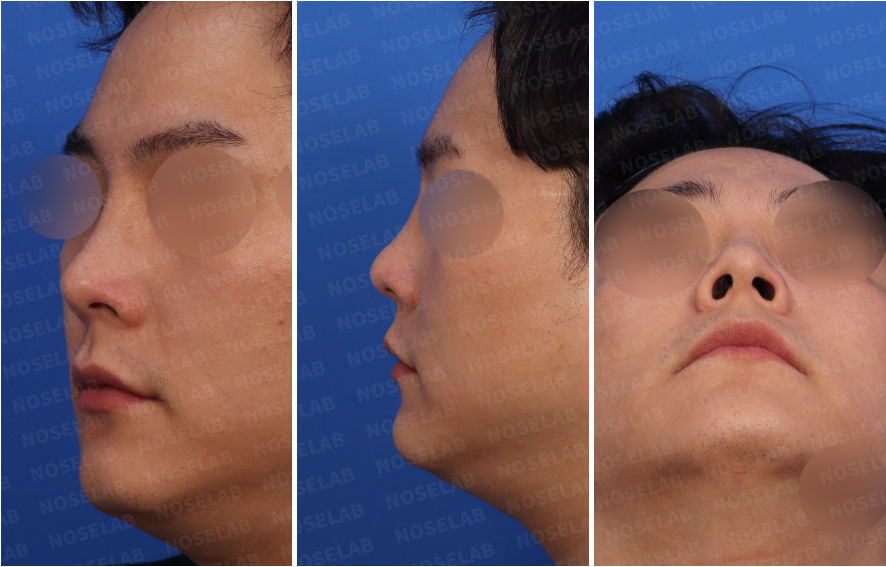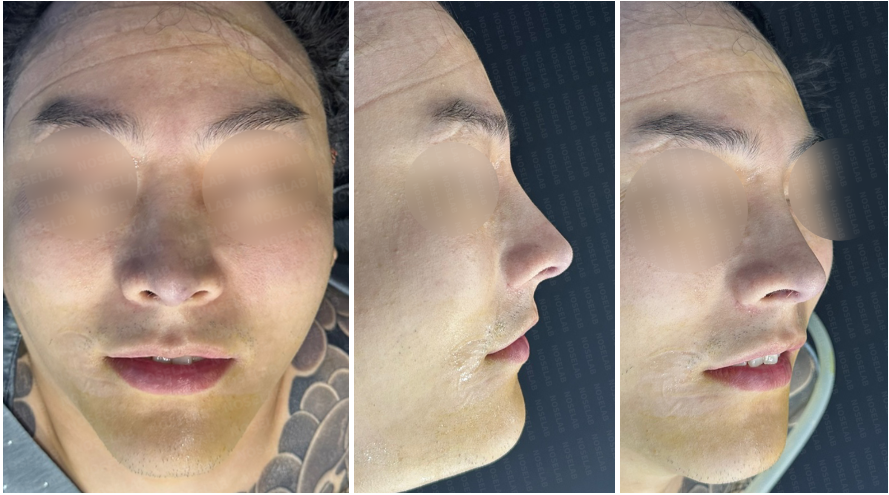Hello, this is Dr. Cha-Young Kang, the head of Nose Lab Clinic.
Today, I’d like to share a rhinoplasty case involving a male patient with a curved, upturned nose.
This patient came to us seeking correction for significant nasal obstruction on the right side and excessive nostril exposure when viewed from the front.
He specifically requested a masculine, straight nose, and this case is particularly interesting because we were able to meet his aesthetic goals while also addressing the functional issues.
1.Preoperative Consultation and Analysis
Patient's Surgical History:
In 2014, the patient underwent multiple procedures at a plastic surgery clinic, including septoplasty, functional nasal surgery to correct a deviated septum, silicone implant insertion, and alar base reduction.
Primary Concerns:
Significant nasal obstruction on the right side, causing difficulty in breathing.
Excessive nostril visibility from the front.
Patient's Requests:
Correction to create a straighter nasal bridge.
Reduction in nostril visibility when viewed from the front.
Preoperative Design Consultation and Photo Analysis:
Here are the preoperative design consultation photos: front view, right oblique view, and side profile view.
Front View:
Excessive nostril visibility.
The nose appears crooked.
Oblique View:
Uneven nasal bridge.
The nasal tip appears upturned.
Side Profile:
The dorsum of the nose is depressed.
The nasal starting point is positioned too high.
The nasal tip appears upturned.
Here are the preoperative design consultation photos: left oblique view, side profile, and nostril view.
Nostril View:
Visible asymmetry in the shape and size of the nostrils.
2. Surgical Plan
Taking into account the patient’s condition and specific needs, we have developed the following surgical plan:
a) Surgery for Improving Nasal Congestion
Septoplasty: Correction of the deviated nasal septum.
Submucosal Resection of the Inferior Turbinate Using Radiofrequency Laser: To reduce the size of the turbinates and improve airflow.
b) Septal Extension Using Autologous Rib Cartilage
Correction of Nostril Asymmetry: To balance the shape of the nostrils.
Correction of Upturned Nose: To improve nasal profile and proportion.
Correction of Crooked Nasal Tip: To achieve a straighter and more symmetric nasal tip.
c) Replacement of Nasal Dorsal Implant
Removal of Existing Implant: To address any issues related to the old implant.
Insertion of New Implant: Placing a new implant, starting at a lower point, to raise the bridge of the nose for a more natural appearance.
3. Surgical Procedure
The following procedures were performed using a closed (endonasal) approach:
a) Surgery for Nasal Congestion:
Septoplasty: The deviated septum was corrected to alleviate right-sided nasal obstruction.
Submucosal Resection of the Inferior Turbinate Using Radiofrequency Laser: This created more space in the nasal passages, improving airflow and breathing.
b) Septal Extension Using Autologous Rib Cartilage:
Rib cartilage was harvested from the patient and used to correct the septal deviation.
Septal Extension: This procedure corrected the nostril asymmetry, lifted the upturned nose, and straightened the crooked nasal tip.
c) Replacement of Nasal Dorsal Implant:
The uneven existing implant was removed.
A new implant was inserted, with the starting point set lower to create a more natural nasal bridge contour.
The curved dorsal line was straightened to emphasize a more masculine appearance.
d) Nasal Tip Correction:
The previously upturned nasal tip was lowered to achieve a more natural, masculine nose shape.
The nasolabial angle (angle between the nose and upper lip) was adjusted to approximately 90 degrees, further enhancing a masculine profile.
All procedures were completed using a closed approach, leaving no visible external scars.
4. Before and After Surgery Photo Comparison
Frontal view before surgery (left) after surgery (right)
The previously overexposed nostrils have been significantly reduced, resulting in a more natural appearance.
The nasal deviation has been corrected, and the once crooked nose now appears straight and aligned.
Side profile view before surgery (left) after surgery (right)
The previously uneven and bumpy nasal bridge has been improved to a smooth, straight line, creating a more refined profile.
The upturned nasal tip has been naturally corrected, resulting in a more balanced and harmonious appearance.
45-degree angle view before surgery (left) after surgery (right)
The previously flattened nasal bridge has been properly elevated, creating a masculine and straight profile.
The high starting point of the nose has been lowered, forming a smooth and natural transition from the forehead to the nose.
The previously upturned nasal tip has been lowered, resulting in a more masculine nasolabial angle that enhances the overall appearance.
Nostrils before surgery (left) after surgery (right)
The asymmetry has been significantly corrected, resulting in a more balanced and harmonious appearance.
5. Collection of Post-Surgery Photos
Photos taken immediately after surgery, frontal view, 45-angle view, and side profile.
Nostril view
6. Conclusion
This case represents a comprehensive rhinoplasty procedure that addressed both functional issues and aesthetic concerns simultaneously. Special consideration was given to creating a straight, strong nasal profile that suits the masculine features of the male patient.
Breathing difficulties were resolved through septoplasty and turbinate reduction surgery. This step was crucial not only for aesthetic improvements but also for enhancing the patient's overall quality of life.
The use of autologous rib cartilage for septal extension played a key role in correcting multiple issues, including nasal asymmetry, upturned nose, and a crooked tip. By utilizing the patient’s own tissue, we can expect long-term, stable results.
In replacing the nasal implant, we focused on achieving a more masculine and straight nasal bridge. The original curved line and high starting point were adjusted to create a robust, masculine appearance.
Finally, tip refinement and adjustment of the nasolabial angle were essential to achieving the ideal masculine nose shape. A nasolabial angle close to 90 degrees effectively highlighted the strong, masculine image.
7. Final Remarks
The ideal shape of a male nose differs significantly from that of a female nose, particularly in the nasal bridge line. Generally, men tend to prefer a straight nasal profile, while women often seek a softer, more curved contour along the nasal bridge. Additionally, the degree of nasal tip rotation is typically less pronounced in male noses compared to female ones.
The ideal nasolabial angle is known to be around 90 degrees for men and approximately 95 degrees for women. In the case of this patient, despite being male, his nose exhibited a curved nasal bridge and a nasolabial angle greater than 95 degrees, resulting in an upturned nose with a noticeable curve. This created a "ski slope" appearance, which can look somewhat unnatural for a male nose.
To correct this, we adjusted the nasal tip to reduce the upturn and removed the curve from the bridge, creating a straighter line. We also modified the nasolabial angle to bring it closer to 90 degrees, achieving a more traditionally masculine nose.
As this case demonstrates, rhinoplasty is not simply about altering the size or shape of the nose. It requires a nuanced approach that takes into account gender and the individual’s facial characteristics. In male rhinoplasty, it's especially important to maintain a strong, masculine appearance while ensuring a natural look.
For men considering rhinoplasty, it’s essential to consult with a specialist to find the nasal shape that best complements your facial structure. At Nose Lab Clinic, we provide personalized rhinoplasty services that reflect your unique needs and personality, backed by extensive experience and expertise.
We are committed to helping you achieve a nose that is both beautiful and healthy. Thank you for choosing Nose Lab Clinic.










Comments